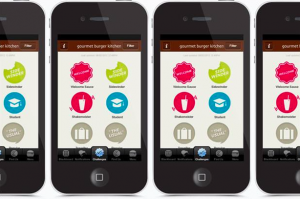Why Do So Many Restaurants Have Their Own ‘mobile app’?
Throughout this year, I have noticed an increase in the amount of restaurants having there own ‘mobile app’. The aim of this blog is to understand what is behind this trend and to find out what benefits a ‘mobile app’ can have on restaurants.
The best place to start is probably to describe what a mobile app actually is. PC Magazine (2015) defines it as being “a software application that runs in a smartphone, tablet or other portable device.” With there being an option to create an app for almost anything, smartphone users can now read the news, see how many steps they’ve taken throughout the day, remember where they parked there car, or just kill time by playing ‘candy crush’ all day – the possibilities are endless!
Heres a few stats..
The Telegraph (2012) reported that there was an average of 701 apps released everyday throughout 2011 and at this moment in time Apple’s “App Store” alone has around 1.4 million apps available (Statista, 2015).This just goes to show that mobile apps are growing at an enormous rate, and businesses should look to include this tool within their marketing mix.

The restaurant industry is leading the trend when in comes to going mobile, heres a very interesting infographic to prove it.
Example: Gourmet Burger Kitchen
So far this year I have been trying to improve the digital marketing strategy for the premium burger chain ‘Gourmet Burger Kitchen’, of whom would be classed in the ‘Fast Casual’ sector in the infographic link above. For the purposes of this blog posting I will be focusing on GBK’s app to see what their app has to offer.

The GBK app was built to accompany their new look website back in 2012 with the aim to create a customer loyalty scheme. Loyalty should now be the driving force behind every businesses marketing strategy as outlined by Erhenberg (1988), who brought forward the concept of “Repeat-Buying”. The notion of creating a mobile app for a restaurant does exactly that as it encourages customers to use the app, and benefit from it through frequent use through the process explained below.
The app allows customers to locate their local outlet and view the menu via a check-in service. Loyalty points are then added to the customer’s personal account by purchasing a meal at one of their restaurants, and can be boosted by playing the app’s game and spreading the word across their personal social media channels. As soon as the customer gains a certain amount of loyalty points, it will equate to free food.
The former CEO, Alasdair Murdoch stated: “We know that now, more than ever, our customers are looking for value, as well as a fun, easy to use loyalty scheme that offers quick rewards. Our new loyalty app offers just that. It allows us to take a more personal approach, rewarding the most frequent customers with extra benefits” (Marketing Magazine, 2012).
Pros:
- High percentage of the population use smartphones.
- Higher level of user engagement (Bellman et al. 2011)
- The advertising is more effective due to it being on your consumers personal device (Wang, 2006)
- Creates a positive attitude towards the brand (Hutton & Rodnick, 2009)
- Branded apps are perceived as “useful” to the users suggesting it could be the most powerful marketing tool yet (Bellman et al. 2011)
Cons:
- App development can be expensive to your brand as they need to be made to suit each mobile platform (iPhone, Android, Windows etc.). Also the more functionality they have, the more expensive they become.
- Mobile Apps require on-going care both as regard to fresh content and technological updates.
- If they offer now benefit to you consumers, then they simply will not buy them.
So restaurant owners, as the old saying goes: if you can’t beat ’em, join ’em!
References
Online Journals:
Bellman, S., Potter, R., Treleaven-Hassard, S., Robinson, J. and Varan, D. (2011). The Effectiveness of Branded Mobile Phone Apps. Journal of Interactive Marketing, 25(4), pp.191-200.
Hutton, G. & Rodnick, S. (2009). Smartphone Opens up New Opportunities for Smart Marketing. Admap, 44(11), pp.22-24.
Wang, A. (2006). Advertising Engagement: A Driver of Message Involvement on Message Effects. J. Adv. Res., 46(4), p.355.
Thanks for the share, a mobile app is a very useful tool for restaurants in today’s world.